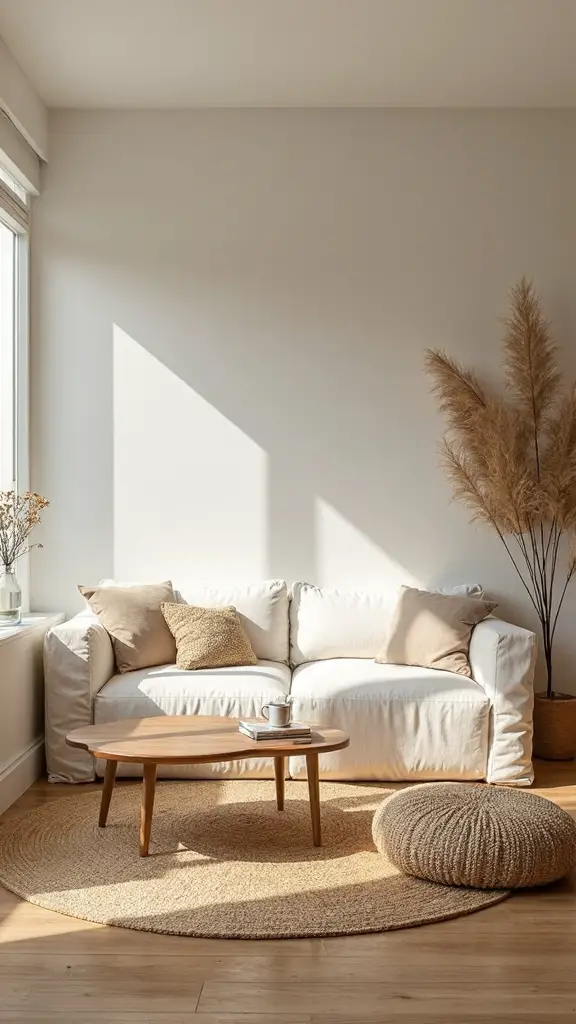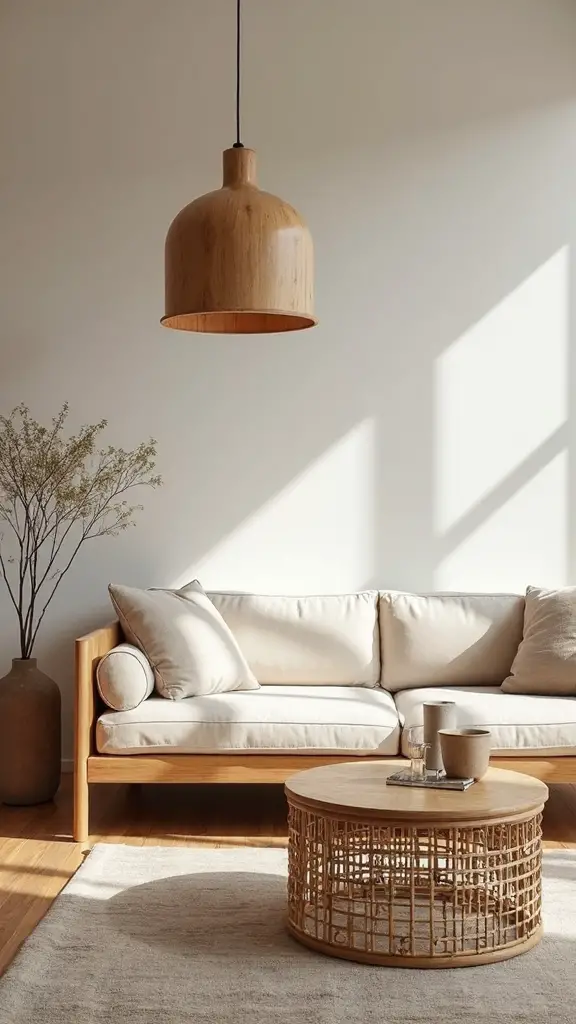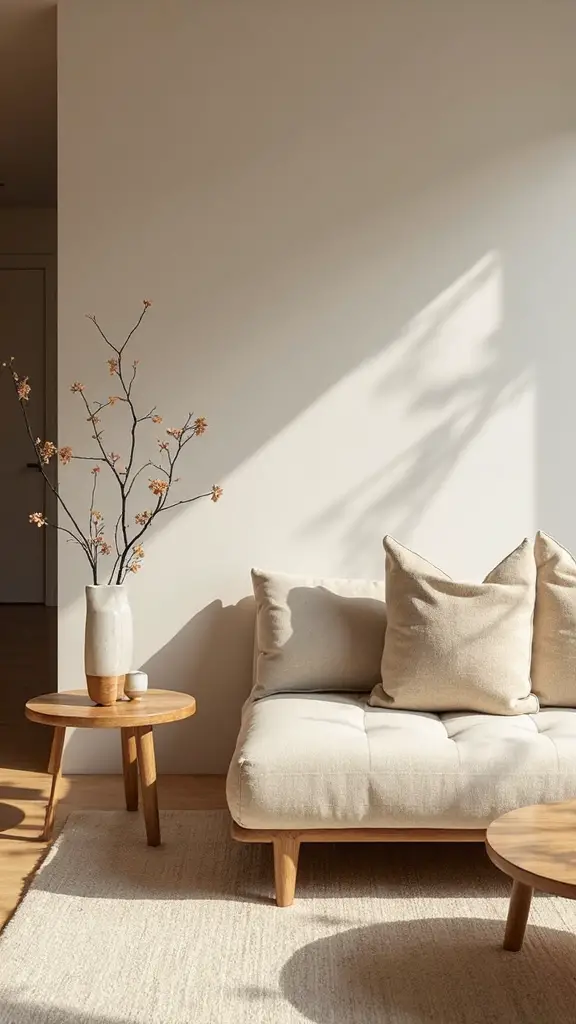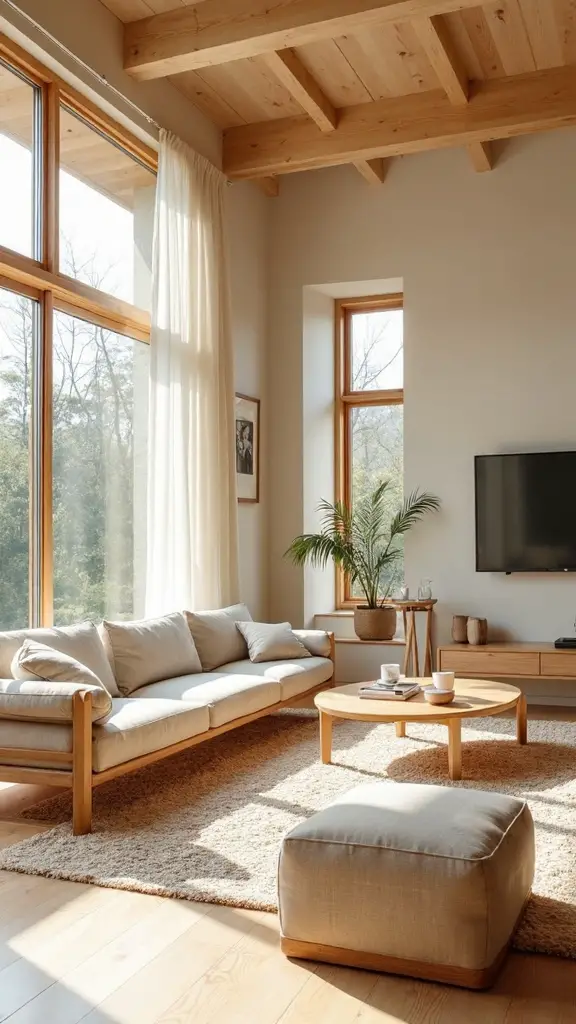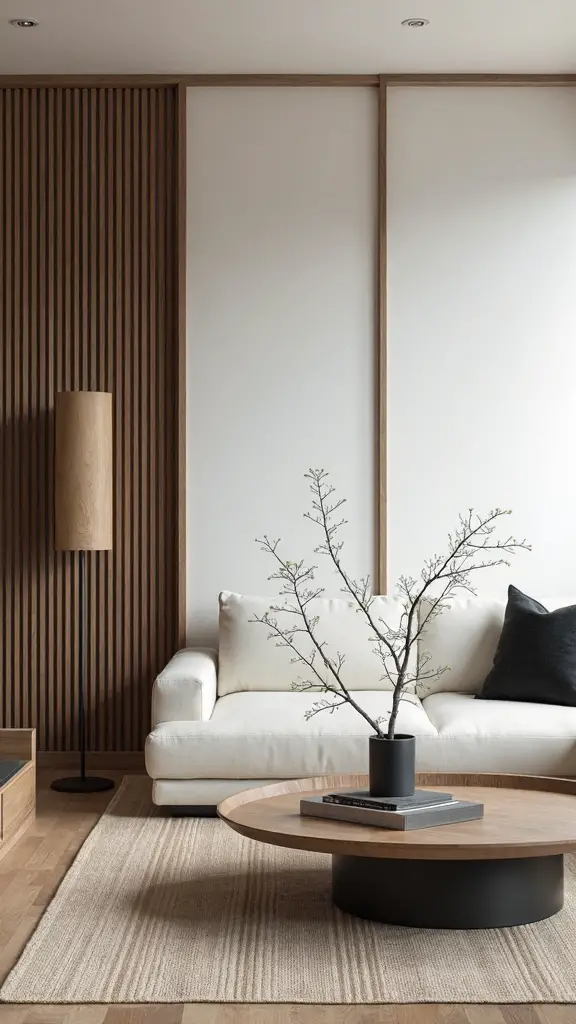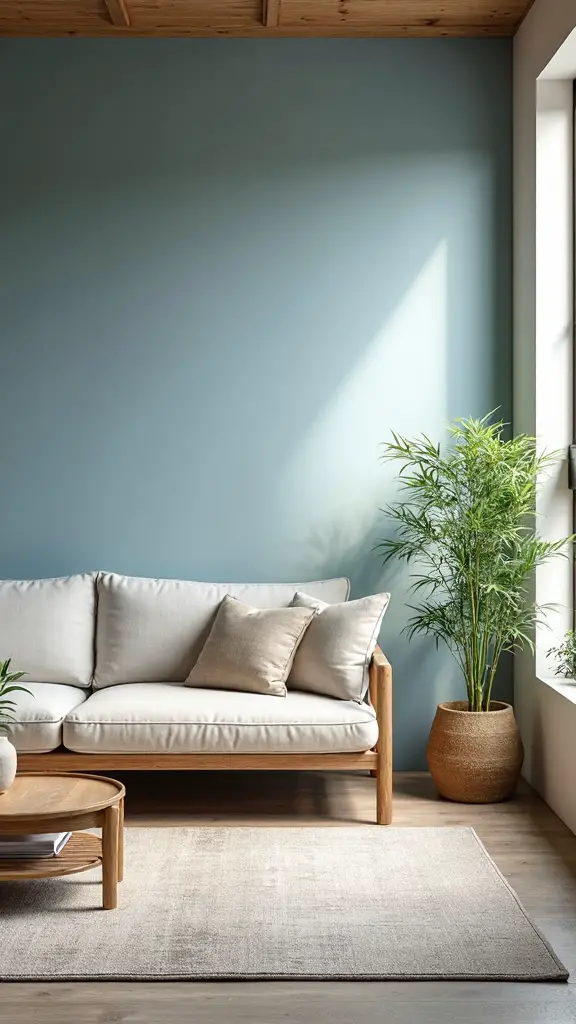18 Japandi Carpet Living Room Designs That Bring Calm, Grace, and Elegance
Stunning Japandi carpet designs transform ordinary living rooms into serene sanctuaries using natural fibers and muted tones that demand closer inspection.
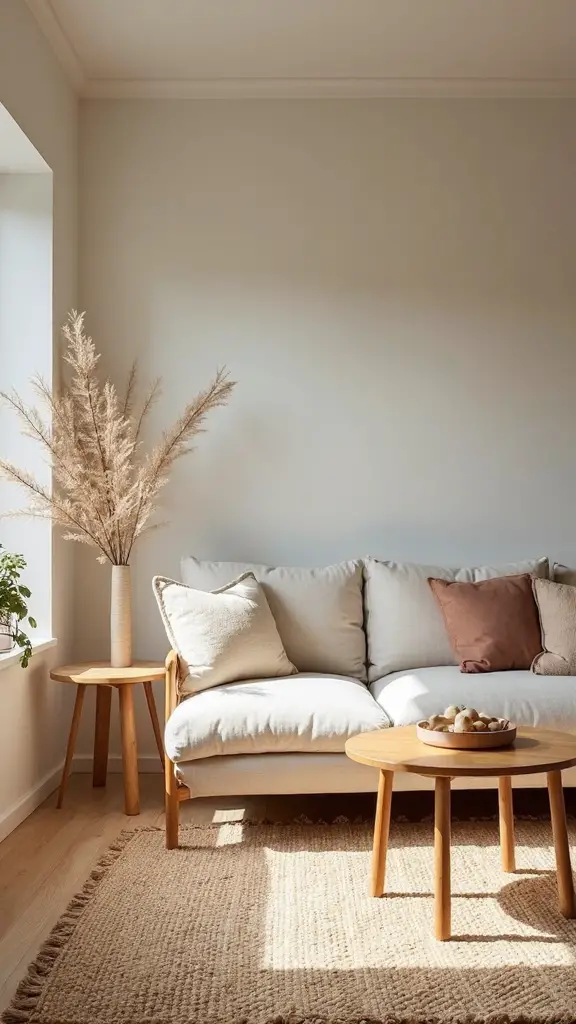
You’ll uncover how the right carpet metamorphoses your living room into a tranquil sanctuary that perfectly captures Japandi design principles. These eighteen meticulously curated designs showcase how natural fibers, muted tones, and thoughtful placement create spaces that feel both grounding and sophisticated. From handwoven jute foundations to plush wool textures, each selection demonstrates the power of understated elegance. The secret lies in understanding which specific combinations of material, pattern, and positioning will release your space’s full potential.
Natural Jute and Cotton Flatweave Foundation for Minimalist Seating Areas
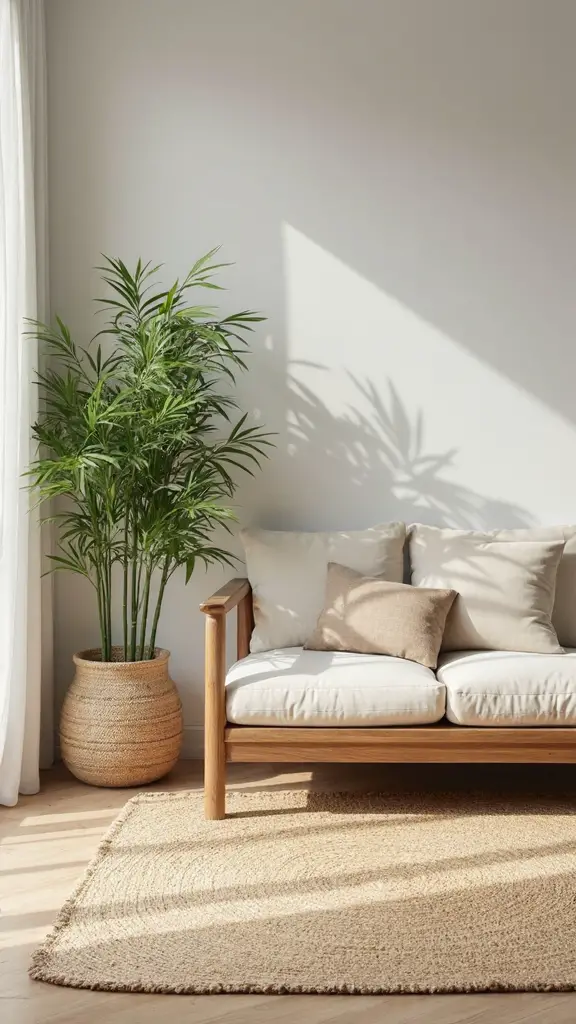
When you’re designing a Japandi living room, a handwoven jute and cotton flatweave rug creates the perfect neutral foundation for your minimalist seating arrangement. This textural flatweave construction beautifully complements natural materials like wooden furnishings and linen upholstery, establishing cohesive organic textures throughout your space.
Position your rug beneath low-profile sofas and chairs to define the seating area while maintaining seamless room flow. The light, neutral palette visually expands your space and infuses tranquility into the atmosphere. You’ll appreciate the durable jute and cotton blend’s low-maintenance properties, making it ideal for high-traffic areas requiring longevity and easy upkeep.
Handwoven Geometric Patterns Creating Visual Harmony in Open Floor Plans
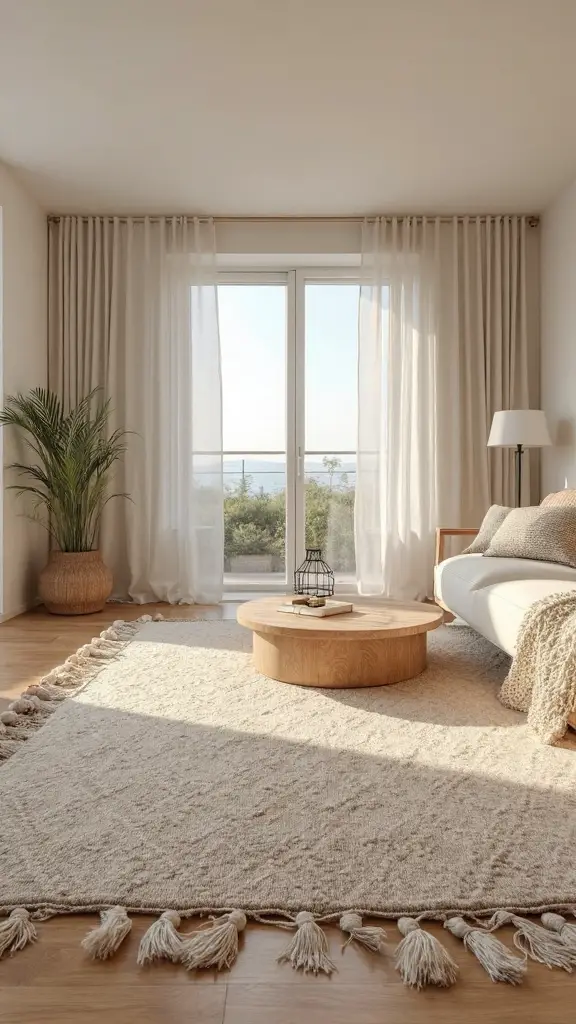
Building upon the solid foundation of neutral flatweaves, handwoven geometric patterns introduce sophisticated visual interest while preserving the calm, uncluttered aesthetic that defines Japandi design. You’ll find these strategic patterns help delineate distinct zones within your open floor plan, creating intimate conversational groupings and defined dining areas without overwhelming the space.
Japandi rugs with clean geometric lines anchor your living spaces beautifully, allowing furniture and artwork to take center stage. The natural texture of wool or jute construction adds tactile depth when paired with smooth wood surfaces and linen upholstery, creating seamless shifts between your kitchen, dining, and living areas.
Cream and Beige Tonal Layers for Sophisticated Neutral Palettes
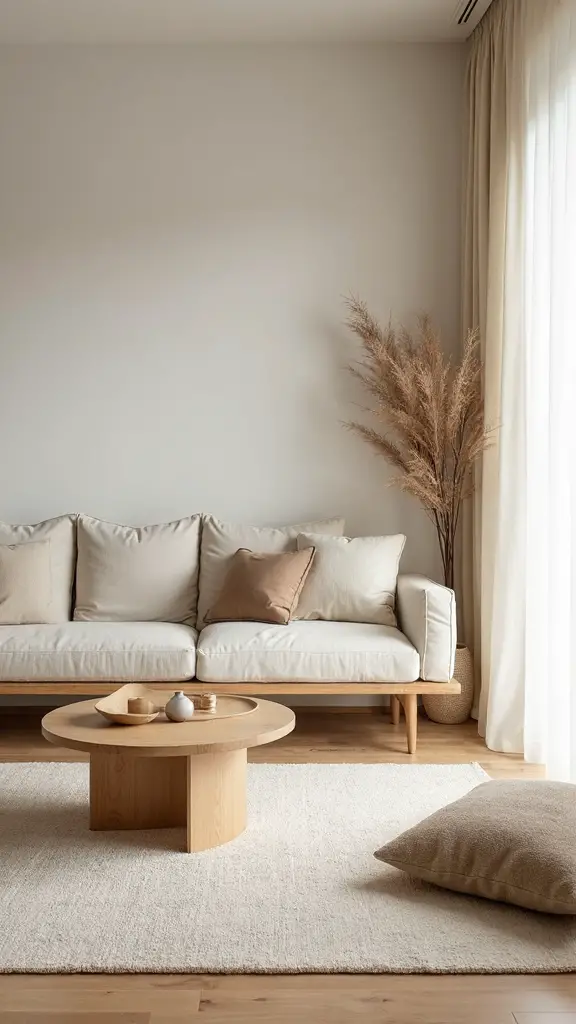
As you move from bold geometric patterns to subtler design elements, cream and beige tonal layers become the cornerstone of sophisticated Japandi interiors that whisper rather than shout. You’ll create a refined foundation by selecting area rugs in these neutral tones, establishing a calming base for your living space.
Layer different textures through plush wool rugs paired with linen upholstery and natural fiber accents. This approach adds visual depth while maintaining the serene atmosphere essential to Japandi design. Combine your neutral-toned rug with dark wood furniture and crisp white walls to achieve that perfect light-filled, harmonious balance.
Sisal and Wool Blend Textures Adding Organic Warmth to Clean Lines
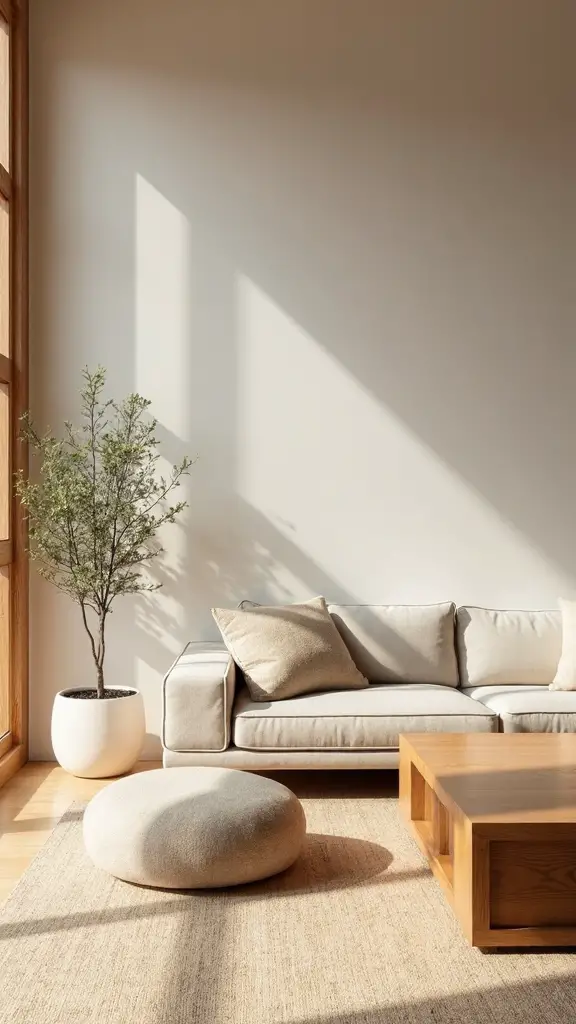
Sisal and wool blend rugs convert sterile minimalist spaces into inviting sanctuaries that perfectly embody Japandi’s marriage of function and comfort. These dual-texture floor coverings combine sisal’s rugged, natural fibers with wool’s luxurious softness, creating tactile contrast that grounds your living room’s clean designer lines.
Choose neutral-toned blends in cream, taupe, or soft gray to maintain visual harmony while introducing organic warmth. The sisal provides durability and earthy texture, while wool adds plush comfort underfoot. Position these rugs beneath seating arrangements to define conversation zones, or use larger pieces to anchor open-concept layouts with natural materiality that enhances Japandi’s serene aesthetic.
Low-Pile Area Rugs Defining Conversation Zones With Subtle Boundaries
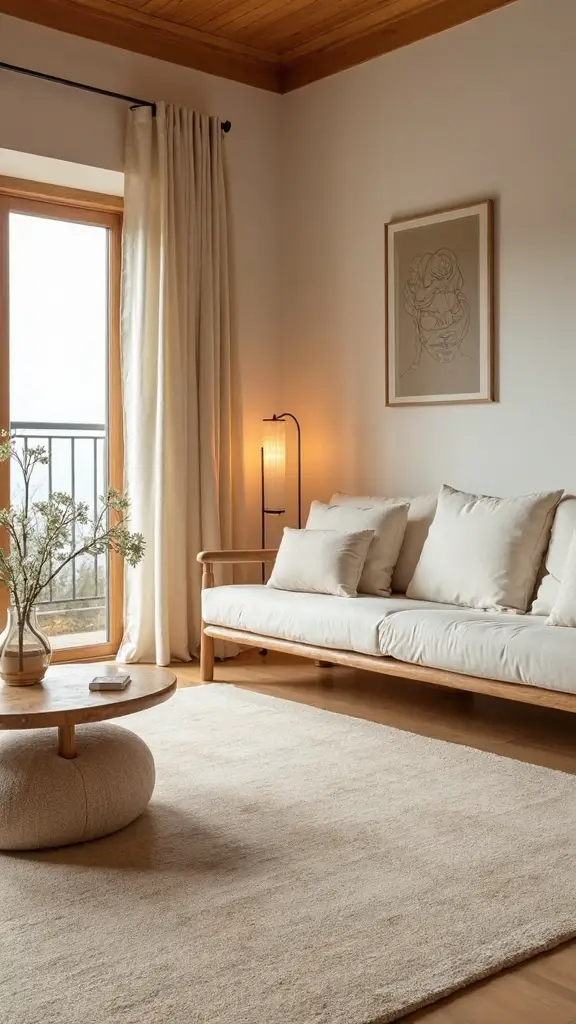
Low-pile area rugs convert sprawling living rooms into purposeful conversation zones without sacrificing Japandi’s signature open, breathable aesthetic. You’ll create distinct seating areas by anchoring furniture groupings with flat-woven jute or wool rugs that maintain minimal visual disruption.
These low-profile area rugs delineate spaces through strategic placement rather than bold statements, allowing your room’s natural textures and [DESIGNER]’s elements to shine. Choose pieces with subtle patterning in neutral tones that complement your existing palette. The understated presence establishes intimate conversation nooks while promoting uninterrupted visual flow throughout your space, perfectly balancing functionality with Japandi’s tranquil minimalism.
Handknotted Artisan Pieces Showcasing Wabi-Sabi Imperfection Philosophy
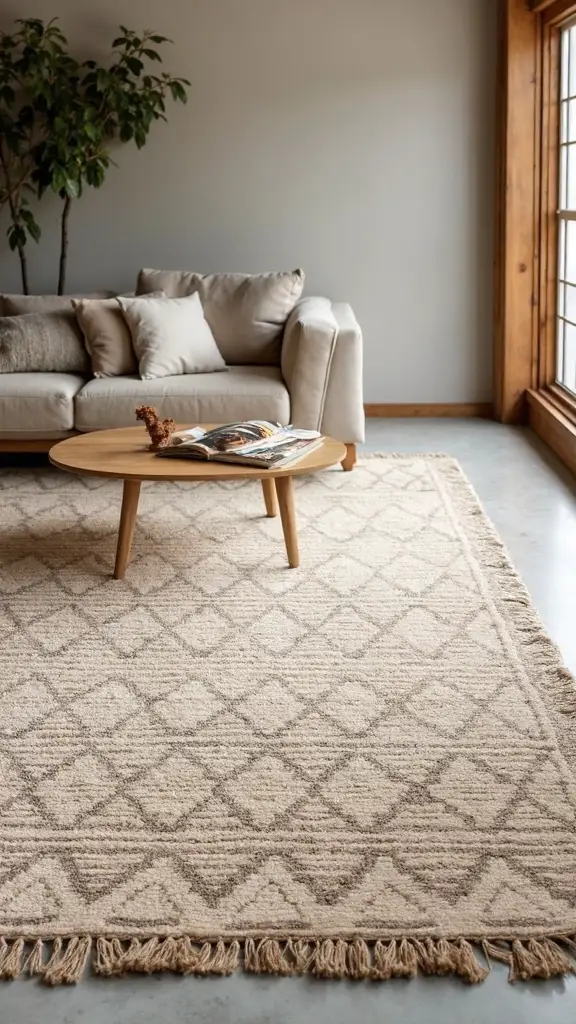
Handknotted artisan rugs convert your Japandi living room into a sanctuary where imperfection becomes the ultimate expression of beauty. These wabi-sabi experts celebrate natural irregularities through subtle variations in texture and shading that machine-made pieces can’t replicate.
You’ll uncover how skilled weavers use premium wool and jute fibers to create organic geometric patterns in muted, earthy tones. The handknotted construction produces slightly uneven edges and gentle color gradations that ground your space with authentic craftsmanship.
Each piece connects you to nature’s inherent imperfections, reshaping your living room into a calming retreat that honors thoughtful artistry over mass-produced uniformity.
Striped Natural Fiber Designs Bringing Contemporary Rhythm to Tranquil Spaces
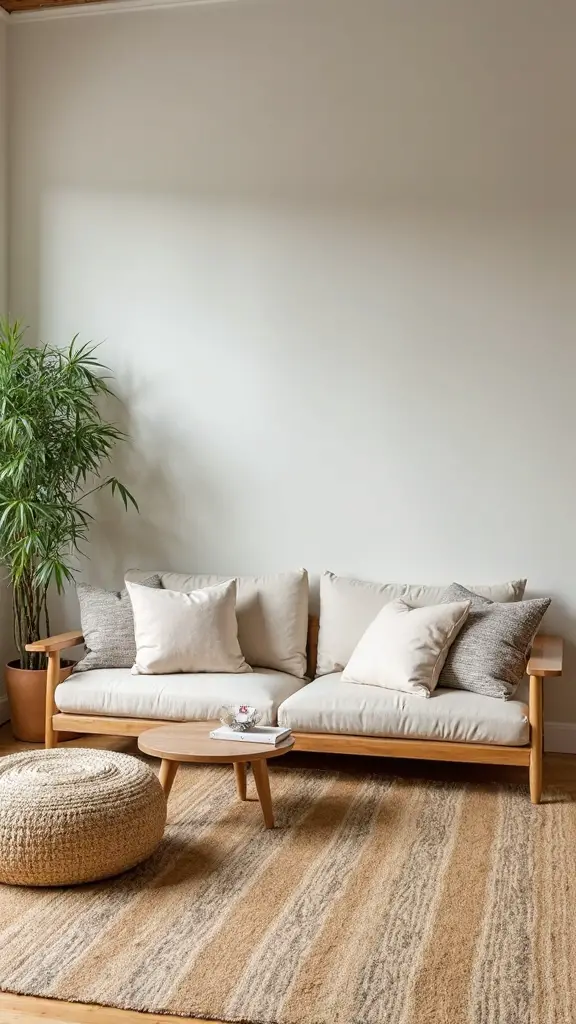
While geometric patterns often dominate contemporary design, striped natural fiber rugs deliver the perfect balance between modern sophistication and Japandi tranquility. You’ll find that handwoven jute and sisal striped rugs create rhythmic visual interest without overwhelming your space’s minimalist aesthetic.
These natural fiber rugs excel at defining distinct living zones within open floor plans, anchoring areas with understated impact. Their muted color palettes allow organic textures to shine while complementing serene Japandi styling.
You can confidently place these durable striped rugs in high-traffic areas, knowing they’ll seamlessly blend with both Scandinavian-inspired sofas and Japanese wooden pieces.
Bamboo and Seagrass Elements Connecting Interior Living to Nature
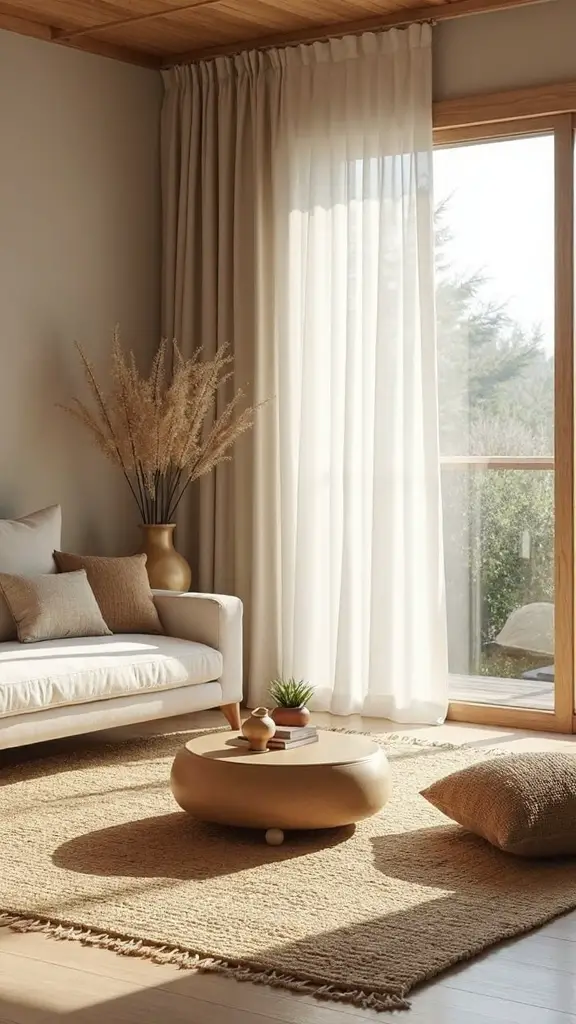
Beyond the structured appeal of striped patterns, bamboo and seagrass carpets introduce an entirely different dimension to your Japandi living room through their inherently organic character. These natural materials create a tactile bridge between your indoor space and the outside world, cultivating tranquility through their renewable, biodegradable properties.
You’ll appreciate how handwoven textures add visual depth while maintaining the minimalist aesthetic that defines Japandi style. Their neutral tones effortlessly complement various furniture pieces, from low-profile sofas to wooden coffee tables, creating a harmonious foundation that enhances your room’s calming ambiance without overwhelming the space.
Soft Accent Rugs Balancing Hard Surfaces With Tactile Comfort
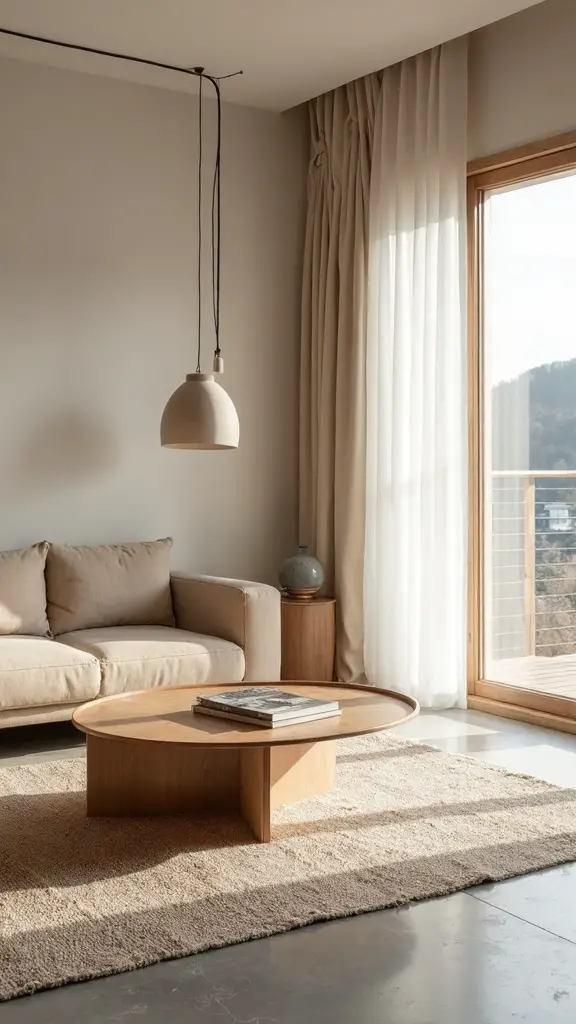
Soft accent rugs alter your Japandi living room by creating essential balance between the style’s characteristic hard surfaces and your need for tactile warmth. Choose plush, medium-pile options in geometric or abstract patterns using neutral hues like cream, sage, or charcoal. A quality Japandi rug grounds your space while complementing clean lines and muted palettes.
Hand-woven natural fibers—jute, sisal, or wool—add organic texture to your living area without overwhelming minimalist furniture. Position rugs strategically to define distinct zones in open-concept spaces, maintaining visual flow while providing necessary softness underfoot that balances concrete accents and hardwood floors perfectly.
Medium-Pile Constructions Offering Understated Luxury Beneath Furniture Groupings
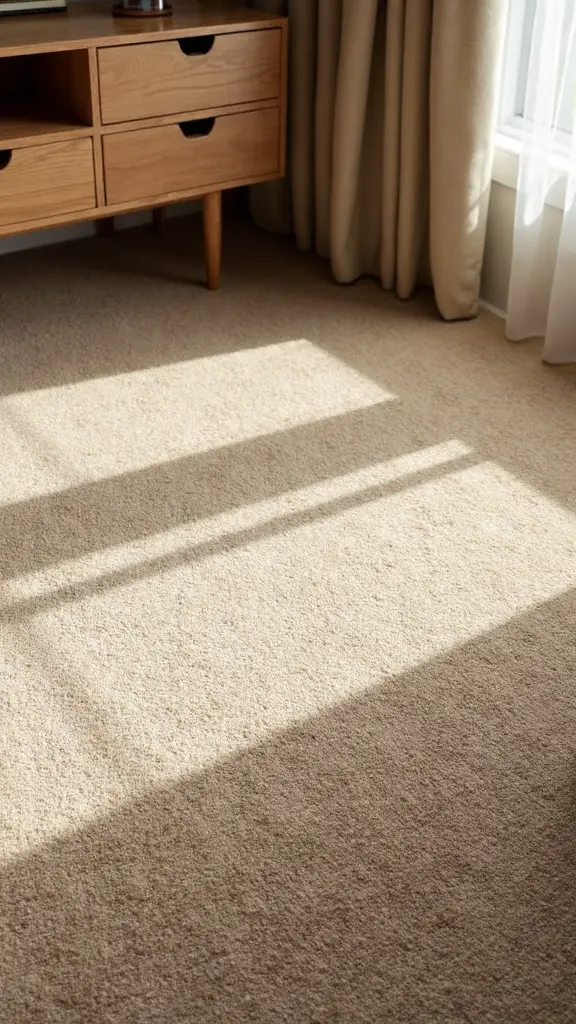
Medium-pile constructions reshape your Japandi living room into a sanctuary of understated elegance, providing the perfect balance between comfort and visual restraint. These Japandi rugs deliver luxurious texture without overwhelming your minimalist aesthetic, creating sophisticated foundations beneath seating arrangements.
Position your medium-pile rug strategically under sofas and coffee tables to establish cohesive furniture groupings. The manageable pile height accommodates chair legs and table bases while maintaining clean sight lines throughout open-concept spaces.
Wool and jute medium-pile options enhance tranquility through their natural materials and subtle textures, grounding your living room with understated luxury that complements rather than competes with surrounding elements.
Tufted Natural Materials Creating Depth Through Monochromatic Color Stories
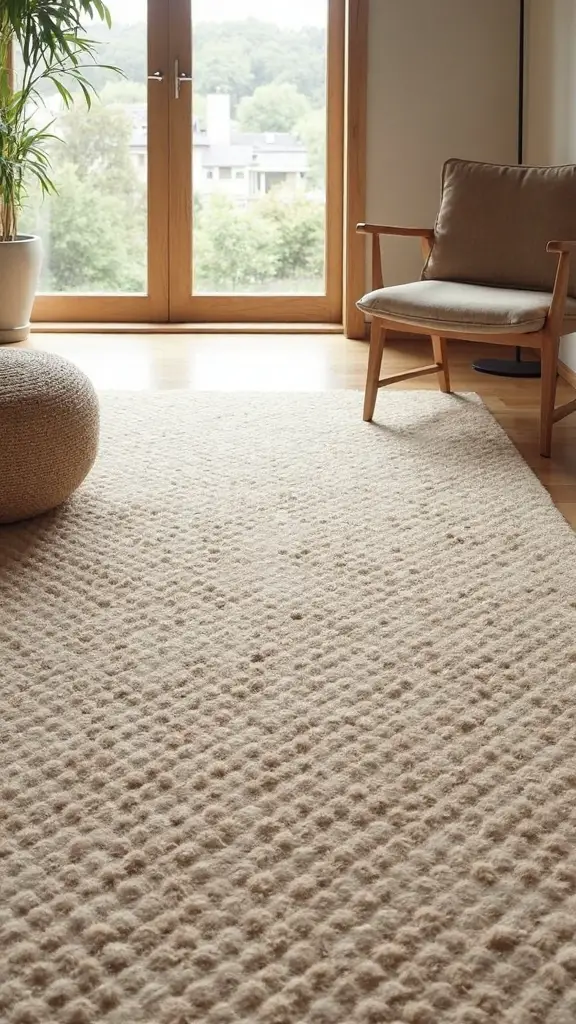
Tufted natural materials redefine monochromatic living spaces into textural artworks that commemorate both Japanese simplicity and Scandinavian warmth. You’ll uncover how jute, sisal, and wool rugs transform your Japandi style room through subtle cream and beige tones that spotlight material richness over bold colors.
Layer different pile heights by combining flat-weave sections with cut-pile areas to create inviting barefoot surfaces. Choose handmade options featuring natural imperfections that honor wabi-sabi principles central to this aesthetic. Incorporate tonal geometric patterns that add visual interest without disrupting your space’s serene atmosphere, achieving sophisticated depth through texture rather than lively hues.
Polypropylene Modern Weaves Supporting High-Traffic Family Living Areas
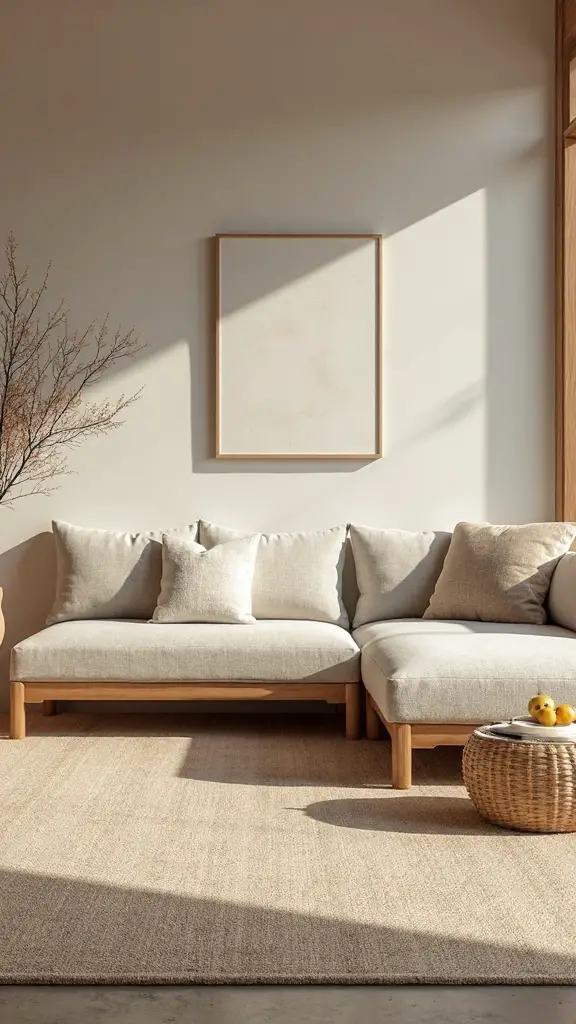
When family life demands durability without sacrificing Japandi’s refined aesthetic, polypropylene modern weaves deliver the perfect balance of practicality and style. You’ll appreciate how these rugs handle daily spills, muddy footprints, and pet accidents while maintaining their sleek appearance.
Modern rugs crafted from polypropylene feature sophisticated geometric patterns and subtle textures that complement bamboo furniture and clean-lined sofas perfectly. Their stain-resistant properties mean you can focus on family moments instead of constant maintenance.
Choose neutral tones like warm grays or soft beiges to create seamless shifts between your rug and natural wood floors, achieving Japandi serenity without compromising functionality.
Persian-Inspired Medallion Motifs Honoring Traditional Craftsmanship Values
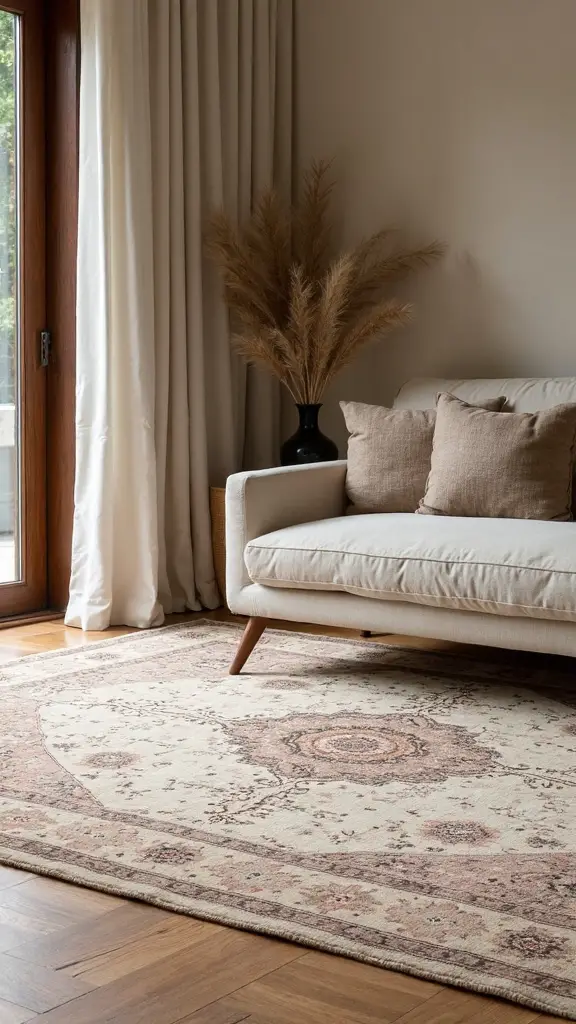
Beyond practical synthetic options lies a world where artisanal excellence meets contemporary Japandi aesthetics through Persian-inspired medallion motifs. These handknotted wool rugs showcase intricate symmetry and muted color palettes that perfectly complement Japanese minimalism and Scandinavian simplicity.
You’ll find the timeless medallion design creates refined sophistication while maintaining the calming atmosphere essential to Japandi living spaces. The geometric forms paired with soft, neutral tones establish visual balance that anchors your room and invites relaxation.
These durable investment pieces honor traditional rug-making craftsmanship while seamlessly integrating into modern interiors, offering exceptional longevity for years of enjoyment.
Multi-Border Designs Framing Seating Arrangements With Architectural Precision
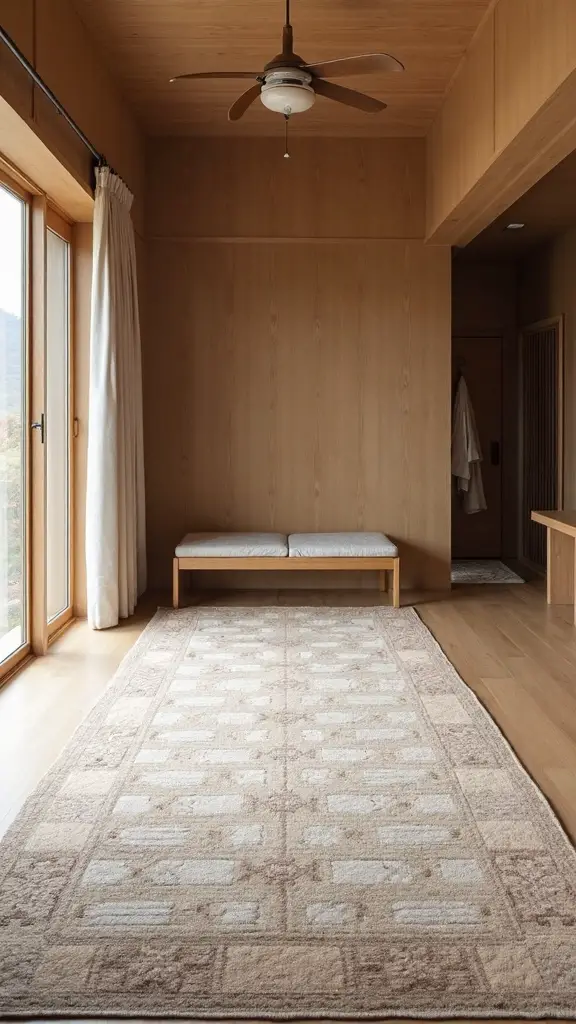
Multi-border carpet designs remodel your Japandi living room into a skillfully orchestrated space where each seating arrangement finds its perfect structural system. These repeating geometric borders create distinct zones within open-concept layouts, anchoring conversation areas with architectural precision.
You’ll uncover how neutral-toned, medium-pile rugs with subtle border patterns define circulation paths while maintaining visual flow throughout your space. The interlocking designs naturally connect living, dining, and work zones, establishing grounded cohesion in Japandi interiors.
Each border motif frames furniture groupings harmoniously, changing your open floor plan into purposefully organized areas that promote both function and tranquility.
Circular and Oval Shapes Softening Angular Room Geometries
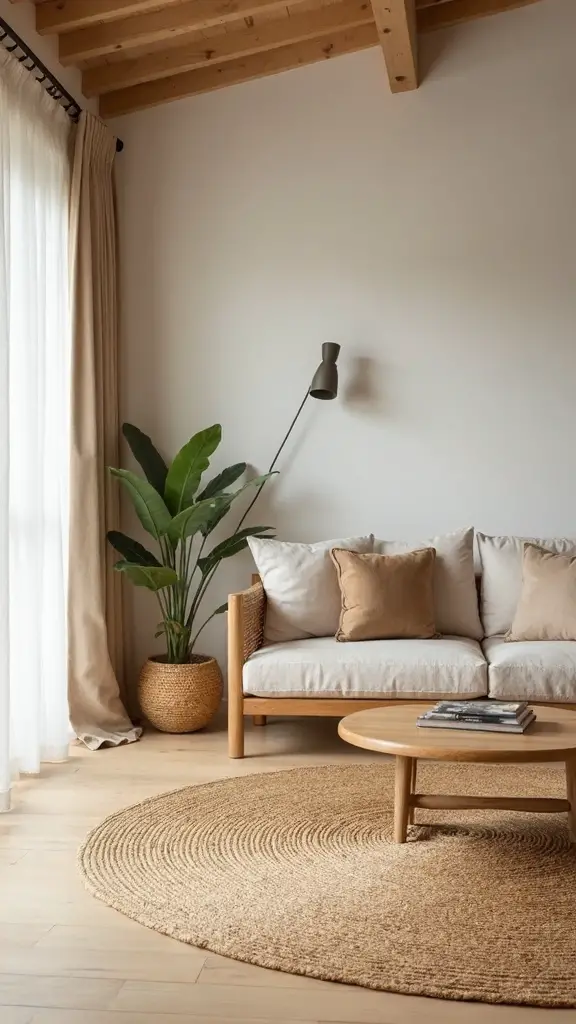
How can you alter a rigid, angular living room into a space that breathes with organic harmony? Choose circular or oval Japandi rugs that counterbalance rectangular furniture’s sharp edges. These curved shapes create visual flow while establishing cozy conversational zones that draw attention to your living space’s center.
Round rugs introduce movement and fluidity, transitioning austere minimalist settings into inviting environments. The organic forms add depth and texture through their gentle curves, softening harsh geometric lines from coffee tables and sofas. You’ll notice how these curvilinear designs make your room feel more welcoming and balanced.
Fade-Resistant Constructions Maintaining Serene Beauty Through Daily Use
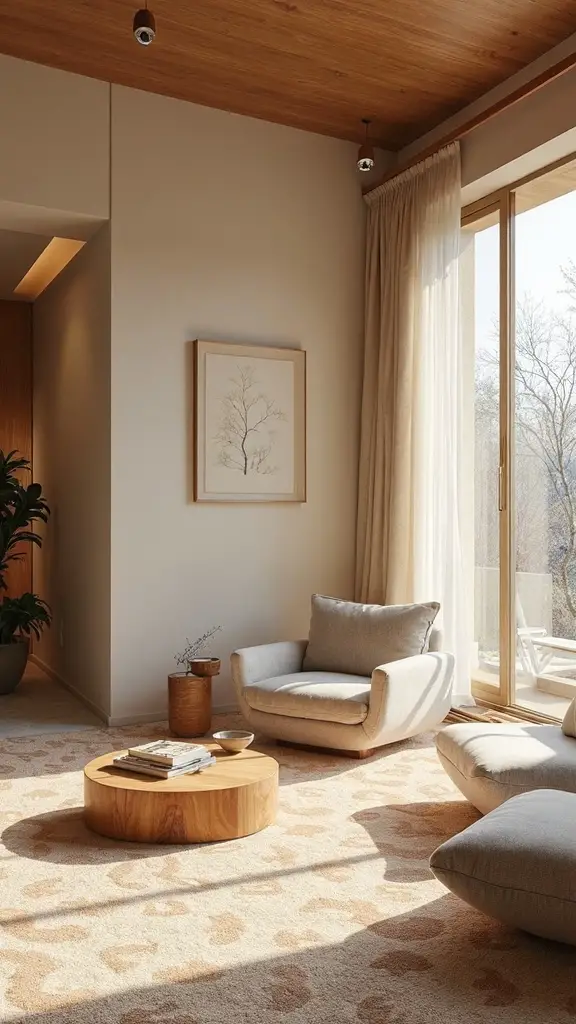
While curved shapes bring visual softness to your living room, the practical durability of your Japandi carpet determines whether that serene aesthetic will persist through years of family gatherings and daily foot traffic.
Fade-resistant construction guarantees your carpet’s muted color palette won’t diminish under sunlight exposure or heavy use. Natural fibers like wool, jute, and cotton provide exceptional durability while maintaining soft texture.
Advanced weaving techniques create stain-resistant surfaces that handle spills gracefully. Your living room maintains its minimalist sophistication because these thoughtfully engineered carpets resist wear patterns and color degradation, preserving their refined aesthetic despite daily demands.
Layered Textile Compositions Building Visual Interest Through Neutral Tones
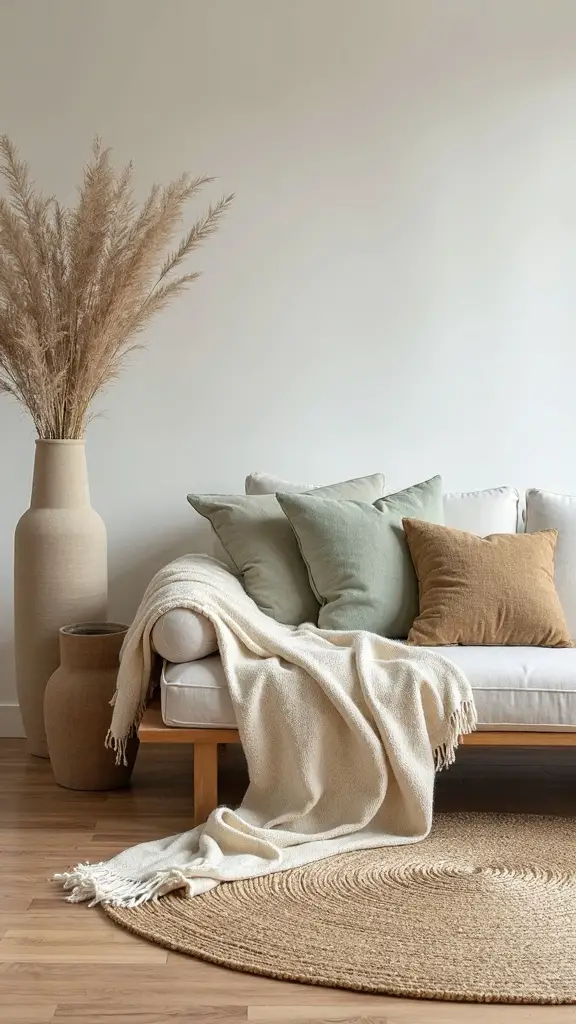
Layered textile compositions alter your Japandi living room from simple to sophisticated by combining multiple neutral-toned pieces that create depth without visual chaos. You’ll achieve this by placing a large jute foundation rug beneath smaller wool accent pieces in complementary beige, cream, or soft gray tones.
Start with a high-quality cotton flatweave as your base layer, then add a smaller textured rug positioned strategically under your seating area. This technique defines zones while maintaining the clean aesthetic that makes Japandi design so appealing in any living room space you’re creating.
Moroccan Plush Textures Introducing Gentle Contrast to Minimalist Aesthetics
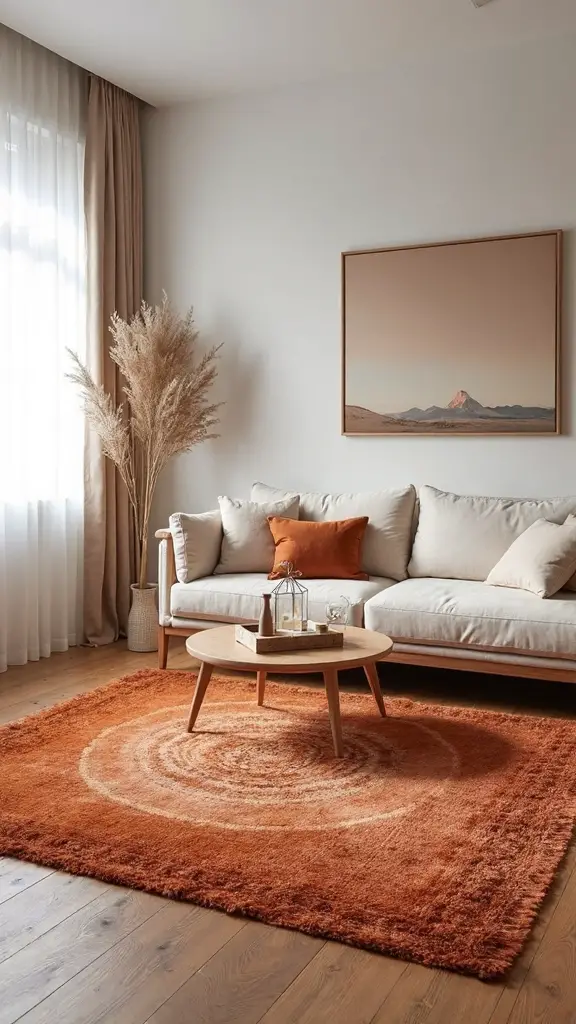
Beyond strategically layered foundations, Moroccan plush textures offer an unexpected yet harmonious enhancement to your Japandi living room’s serene atmosphere. These high-pile rugs in neutral beiges and grays introduce tactile warmth without compromising Japanese design principles of simplicity and balance.
You’ll find their lush, fluffy surfaces create gentle visual contrast against clean furniture lines while maintaining essential minimalist aesthetics. Pair your Moroccan plush rug with handwoven jute accents and natural materials like wood or rattan to amplify textural harmony. This thoughtful combination adds inviting comfort and cozy elements that complement rather than overwhelm your space’s peaceful, pared-down foundation.
Conclusion
You’ve uncovered how Japandi carpets metamorphose living spaces through thoughtful material choices and intentional placement. These natural fiber rugs create peaceful foundations that’ll anchor your furniture while maintaining the style’s signature minimalist elegance. Whether you choose jute flatweaves or plush wool textures, you’re investing in timeless pieces that bring lasting tranquility to your home. Start with one quality rug and watch your space evolve into a serene sanctuary.
